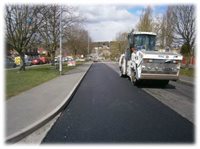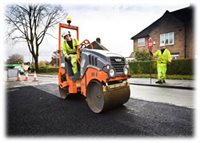Asset investment
Potholes are a symptom of a damaged or worn out road/footway. When the surface has reached its end of life a structural maintenance scheme is necessary.

These schemes involve the removal and replacement of the old material and have varying costs per square metre (up to £150 per square metre), depending on the depth and length of surfacing needing to be removed and replaced. As these works are extensive, each one requires a very significant proportion of investment from the highway maintenance budget.
It is much better value for money to invest in increasing the lifespan of surfaces through the periodic preventative maintenance treatment of road or footway surfaces which are already in a good condition. These effectively protect the structures from the ingress of water and restore the skid resistance properties. Furthermore, they help to delay end of life symptoms by about 15 years with each treatment.
Each treatment is bespoke to the road/surface type and the cost varies per square metre (up to £10 per square metre), depending on the type of treatment used and the level of skid resistance required. However, the costs are significantly lower per square metre compared to structural maintenance schemes.
Preventative maintenance
Preventative maintenance treatments such as surface dressing*, micro asphalt, footway slurry sealing, etc, are used to preserve and extend the life of roads that are already in a reasonable to good condition.
 It is crucial that these treatments are undertaken before serious deterioration has taken place rather than repairing inevitable deterioration through routine and reactive maintenance works and eventually, structural maintenance schemes which cause increased traffic congestion and are much more expensive and time consuming.
It is crucial that these treatments are undertaken before serious deterioration has taken place rather than repairing inevitable deterioration through routine and reactive maintenance works and eventually, structural maintenance schemes which cause increased traffic congestion and are much more expensive and time consuming.
If roads did not benefit from preventative treatments they would require replacement three or four times as often. Most preventative treatment applications are usually completed at each site within the same day although some preparation works might be required beforehand with subsequent lining and cat’s eye replacement works following after.
The carriageway preventative maintenance season is from late March or April to September. Footway preventative treatments are carried out all year round and these may take place outside of normal working hours or on restricted working days. All preventative treatments are weather dependent which can affect the length of the working day or when they commence.
For further information on preventative maintenance treatments, please visit our road surface treatments* page.